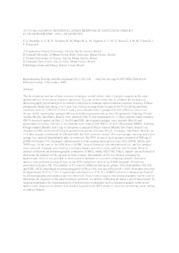Evaluation of superovulatory response in Santa Inês ewes by ultrasonography and laparoscopy.
Evaluation of superovulatory response in Santa Inês ewes by ultrasonography and laparoscopy.
Author(s): BRANDÃO, F. Z.; ARASHIRO, E. K. N.; HENRY, M.; FIGUEIRA, L. M.; SOUZA, J. M. C.; VIANA, J. H. M.; FONSECA, J. F. da
Summary: The development and use of non-invasive techniques would reduce risks of surgery sequels on the same animal and use of the donor could be optimized. The aim of this study was to evaluate the accuracy of ultrasonography performed prior to embryo collection to estimate superovulation response in sheep. Fifteen pluriparous Santa Inês sheep, 2 to 5 year old, with an average body weight of 46.79 ± 6.00 kg and body condition score of 2.96 ± 0.32 (1 to 5 scale) were allocated into 3 groups (GI, GII, GIII) in a cross-over design. In GI, intravaginal sponges (60 mg of medroxyprogesterone acetate; Progespon®, Schering Plough Animal Health, São Paulo, Brazil) were inserted (Day 0) and maintained for 14 days, and the superovulatory (SOV) protocol started on Day 12. In GII and GIII, intravaginal sponges were inserted (Day 0) and maintained for 6 days. On Day 5, the animals were treated with 300 IU of eCG (Novormon 5000®, Schering Plough Animal Health) and 5 mg of dinoprost (Lutalyse® Pfizer Animal Health, São Paulo, Brazil) i.m. Animals in GIII received 0.025 mg of gonadorelin acetate (Gestran-Plus®, Tecnopec, São Paulo, Brazil) i.m. 12 h after sponge withdrawal. In GII and GIII, the SOV protocol started 48 h after sponge removal and a new sponge was inserted immediately after its removal. The SOV protocol in all groups consisted of 200 mg of pFSH (Folltropin-V®, Tecnopec) administered in 6 decreasing doses given every 12 h (50/50, 30/30, and 20/20 mg). At the time of the fifth dose of pFSH, 5 mg of dinoprost was administered i.m. and the sponges were removed. Animals were bred by a sexually mature ram twice a day until the end of estrus. Prior to embryo collection, an ultrasonographic evaluation (5 MHz, Aloka SSD-500, Tokyo, Japan) was performed to determine the number of CL present on both ovaries. The number of CL was further evaluated by laparoscopy, when it was possible to detect poor responders or even non-ovulating animals. Statistical analysis was performed using all tests at the 95% confidence interval by SAEG program. Results are presented as mean ± SE. The number of CL was not different among all groups. The total number (GI, GII, and GIII) of CL determined by ultrasonography (9.09 ± 5.01) was not different (P > 0.05) from that observed by laparoscopy (8.87 ± 5.25). A significant correlation (r = 0.56, P < 0.0005) between evaluation performed by ultrasonography and laparoscopy was observed. These results suggest that ultrasonography can be used to determine the response to the superovulatory protocol. As embryo collection in sheep is performed mainly by surgical techniques, the implementation of non-invasive techniques such as ultrasonography could avoid unnecessary surgeries on animals that did not respond to the SOV protocol, therefore preventing early culling of embryo donors. Top Print this pagePrint Email this page View Issue Contents Abstract Export Citation Tools Print Bookmark Email this page Early Alert Subscribe to our Early Alerts for the latest journal issue contents.
Publication year: 2010
Types of publication: Abstract in annals or event proceedings
Unit: Embrapa Goats & Sheep
Observation
Some of Embrapa's publications are published as ePub files. To read them, use or download one of the following free software options to your computer or mobile device. Android: Google Play Books; IOS: iBooks; Windows and Linux: Calibre.
Access other publications
Access the Agricultural Research Database (BDPA) to consult Embrapa's full library collection and records.
Visit Embrapa Bookstore to purchase books and other publications sold by Embrapa.

